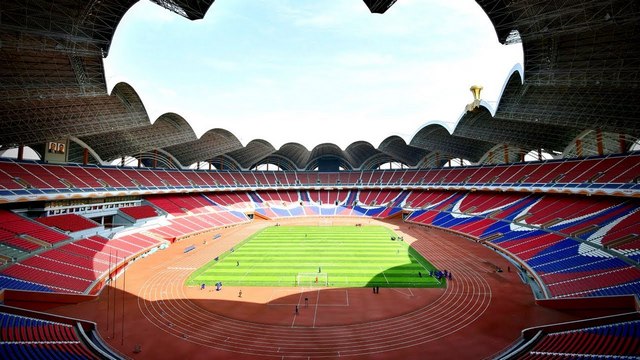Want to buy pyrotechnics? Visit pyro.ultras-tifo.net

Asia, with its diverse cultures and burgeoning economies, has become a major player in the world of sports. The construction of massive stadiums has not only allowed countries to showcase their prowess in hosting significant sporting events but also served as a reflection of their growth and development.
But what makes these colossal arenas truly remarkable?
Let’s embark on a journey through the biggests football stadiums in Asia and delve into their unique features, architectural marvels, and the impact they have on the football culture in this vast and diverse continent.
- This article explores the ten largest football stadiums in Asia, their capacities and unique features. It examines how these iconic arenas have had a profound impact on Asian football culture by providing an iconic stage for tournaments, stimulating economic growth and fostering a vibrant atmosphere. Future expansions of existing stadiums as well as new stadium projects demonstrate Asia’s commitment to advancing sports infrastructure and developing football.
Rungrado 1st of May Stadium
The Rungrado 1st of May Stadium, located in North Korea, is an architectural marvel that dwarfs all other stadiums in Asia. With a staggering capacity of 150,000, it is primarily used for football matches, athletics events, and the iconic Arirang Festival, a mass games event that attracts over 100,000 people. This colossal arena serves as a symbol of national pride and a testament to North Korea’s infrastructural prowess.
The Rungrado 1st of May Stadium:
- Derives its name from its location on Rungra Island and the day of its completion, May 1st
- The main pitch spans a vast 242,000 square feet and is suitable for various sports, including rugby teams
- Has not only captured the attention of the world with its sheer size but has also played a significant role in shaping the sports culture in the region.
Maps: https://maps.app.goo.gl/cNLu6N1WmRPSoZSv8
Bukit Jalil National Stadium
As the largest stadium in Southeast Asia, the Bukit Jalil National Stadium in Kuala Lumpur, Malaysia, stands as a symbol of pride and unity for the nation. With a seating capacity of 87,411, this multi-purpose stadium was inaugurated on January 1, 1998, and designed by the renowned architect firm Populous. It is also the proud home ground for the Malaysian national football team.
Built to host the 1998 Commonwealth Games, the Bukit Jalil National Stadium has since been the site of numerous memorable sporting events and concerts by internationally acclaimed artists. Its modern facilities and iconic design have made it a popular venue for significant sporting matches and world-class musical performances, boosting Malaysia’s profile in the international sports arena and contributing to the growth of football culture in the region.
Maps: https://maps.app.goo.gl/kGqTeQxJjk39VcLw6
Salt Lake Stadium
The Salt Lake Stadium in Kolkata, India, is a hub of football passion, accommodating a whopping 85,000 spectators. Home to football clubs ATK Mohun Bagan, East Bengal, and Mohammedan, the stadium also serves as the stage for the Indian national football team.
Salt Lake Stadium has played host to some of the most significant football events in the country, such as the 2017 U-17 FIFA World Cup and the Pre-World Cup Tournament in 1985. With its impressive capacity and rich history in hosting elite football competitions, the stadium has played a pivotal role in nurturing and promoting football culture in India.
Maps: https://maps.app.goo.gl/iFPUg7oTnKSMFo1c7
Shah Alam Stadium
Located in Shah Alam, Malaysia, the Shah Alam Stadium is an architectural masterpiece with a seating capacity of 80,372. Built in 1994 and designed by the Malaysian architect Hijjaz Kasturi, the stadium’s iconic roof structure and sail-like exterior have made it a recognizable landmark in the world of sports.
As the home ground for the Selangor football team, the Shah Alam Stadium has hosted numerous sporting events, tournaments, and concerts, making it a significant contributor to the region’s football culture and a symbol of Malaysia’s commitment to the growth and development of the sport.
Maps: https://maps.app.goo.gl/6Fpkw7ycfFrkAg617
Beijing National Stadium
The Beijing National Stadium, also known as the Bird’s Nest, is a marvel of modern architecture. With a seating capacity of 80,000, this iconic stadium is home to the China national football team and has hosted several international football matches, including the 2008 Summer Olympics. The old national stadium, which preceded the Bird’s Nest, holds a significant place in the history of Chinese sports.
Designed by Swiss architects Jacques Herzog and Pierre de Meuron, the stadium’s unique structural form is inspired by a bird’s nest and resembles Chinese-style crazed pottery. The Bird’s Nest has not only become a symbol of China’s architectural prowess but has also played a significant role in shaping the country’s football culture and drawing international attention to the sport in Asia.
Maps: https://maps.app.goo.gl/HM5nnTRLMvTurWCo8
The Impact of Large Stadiums on Asian Football Culture
The impact of large stadiums on Asian football culture cannot be overstated. These colossal arenas have become iconic symbols of the sport, hosting major tournaments such as the World Cup and the Asian Cup. Their popularity has led to Asia having the largest fan base of football in the world, further cementing the sport’s importance in the region.
Moreover, the presence of large stadiums has stimulated economic growth, drawing businesses and tourists to the nearby areas. The modern stadium designs inspired by these events have become a benchmark for stadium architecture in the region. By providing a stage for world-class sporting events and fostering a vibrant and energetic atmosphere, these massive stadiums continue to play a pivotal role in nurturing and promoting football culture in Asia.
Summary
From the colossal Rungrado 1st of May Stadium to the architecturally stunning Bird’s Nest, Asia boasts some of the most impressive and awe-inspiring stadiums in the world. These massive arenas serve as symbols of national pride, a testament to the countries’ infrastructural prowess, and a stage for world-class sporting events. Their unique features and architectural marvels have captivated audiences worldwide, contributing to the growth and development of football culture in Asia.
As new stadiums continue to emerge on the horizon, it is evident that the passion for sports and the impact of these colossal arenas on football culture in Asia will only continue to grow. They stand as a testament to the region’s dedication to sports and its desire to leave an indelible mark on the world stage, inspiring future generations to come.











